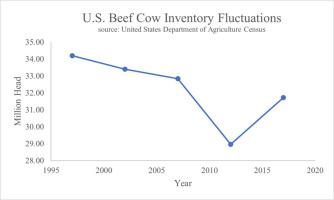Agricultural Systems ( IF 6.1 ) Pub Date : 2021-07-09 , DOI: 10.1016/j.agsy.2021.103212 M.A. Buddhika Patalee 1 , Glynn T. Tonsor 2

|
CONTEXT
Significant seasonal weather changes can create uncertainty in cattle markets due to resulting decreased cattle performance, increased animal mortality rates, and elevated production costs. Significant fluctuations in the number of beef cow inventories are a result of market conditions and weather changes. In addition, changes in industry structure, forage availability, and cost of transporting animals versus forage have caused geographic movement of the cow-calf sector in the United States. Cows are usually pasture-raised year-round, thus fulfilling nearly two-thirds of their forage requirements. Changes in weather, however, can directly affect forage quantity and quality, potentially directly impacting animal growth through feed intake.
OBJECTIVE
Because weather impacts on cow-calf production in the United States has received minimal research attention, this paper provides new empirical evidence of weather effects on location and production of the cow-calf industry.
METHODS
An econometric model of location and production is developed to examine the impact of temperature and total precipitation changes for each season, and economic factors on the spatial structure and geographical location of cow-calf production in 25 major cow-calf producing states in the U.S.
RESULTS AND CONCLUSIONS
The results show that seasonal temperatures and total seasonal precipitation significantly impact county-level beef cow inventories and operational locations. The results also reveal significant spatial patterns relative to positive correlations of beef cow inventories across counties.
SIGNIFICANCE
Changes in production resulting from weather changes ultimately affect operational profits. Knowledge regarding the economic impacts of increases in seasonal average temperature and precipitation variability on cow-calf production is needed by producers to develop risk-mitigating practices and production planning. Significant spatial patterns are also important for sector-specific development and concentration because understanding the importance of the spatial location of cow-calf operations may help policymakers formulate effective policies to facilitate sector development.
中文翻译:

天气对美国牛犊产业位置和生产的影响
语境
由于导致牛性能下降、动物死亡率增加和生产成本升高,显着的季节性天气变化会给牛市场带来不确定性。肉牛库存数量的显着波动是市场条件和天气变化的结果。此外,行业结构、草料供应以及动物与草料运输成本的变化导致了美国牛犊部门的地理移动。奶牛通常全年在牧场饲养,从而满足其近三分之二的草料需求。然而,天气的变化会直接影响草料的数量和质量,可能通过采食量直接影响动物的生长。
客观的
由于天气对美国牛犊生产的影响很少受到研究关注,本文提供了天气对牛犊产业位置和生产影响的新经验证据。
方法
建立了位置和产量的计量经济学模型,以研究每个季节的温度和总降水量变化的影响,以及经济因素对美国 25 个主要牛犊生产州的牛犊生产空间结构和地理位置的影响
结果和结论
结果表明,季节性气温和季节性降水总量显着影响县级肉牛库存和运营地点。结果还揭示了与各县肉牛库存正相关的显着空间模式。
意义
天气变化导致的生产变化最终会影响运营利润。生产者需要了解季节性平均温度升高和降水变化对牛犊生产的经济影响,以制定风险缓解措施和生产计划。重要的空间模式对于特定部门的发展和集中也很重要,因为了解牛犊作业空间位置的重要性可能有助于政策制定者制定有效的政策以促进部门发展。











































 京公网安备 11010802027423号
京公网安备 11010802027423号